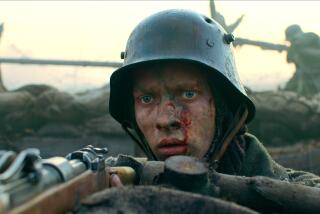The Case Against Sound Advice
- Share via
Good communications are essential in warfare. But before the age of modern electronics, generals had to rely on runners and, more often, their own ears to tell them what was going on.
Too often, their ears would betray them. Unusual weather conditions, intervening sound barriers and other factors often prevented crucial information from reaching them.
At least seven battles in the Civil War were lost because crucial information did not reach commanders in time. Historians have long been aware of how the tides of these battles shifted, but physicist and Civil War buff Charles Ross of Longwood College in Farmville, Va., has for the first time shown why.
Unusual acoustical events in wars have been noted since the Four-Day Battle on the sea between the coasts of England and Holland in 1666. Cannon fire and other battle sounds were clearly heard at many points around England, but not at intervening locations. Passengers on a yacht positioned between the battle and England heard nothing.
Guns fired at the funeral of Queen Victoria in London in 1901 were heard in Scotland, but not in wide areas of northern England. The German bombardment of Antwerp in World War I was heard clearly for a 30-mile radius and beyond a 60-mile radius, but not between.
The Shadow Syndrome
These effects are generally called acoustic shadows and have a variety of causes, according to Ross. One is simple absorption by material--such as soil, forest or snow--between the source and the listener.
A second cause is wind direction and shear. Usually, Ross says, sounds are more likely to be heard downwind of a source than upwind. Winds aloft are generally faster than those at ground level. The upper part of the sound wave will travel faster than the lower part when traveling with the wind, so sound will be refracted back down to the ground at a distance, passing over intermediate points.
When sound is traveling against the wind, the upper part of the sound wave will travel more slowly and sound will be refracted upward, so that it cannot be heard as far away.
The third major factor is temperature inversion. Sound waves travel faster in warmer air. Normally, air temperature decreases with altitude, causing sound to refract upward and decreasing audibility along the ground. On clear, cool nights and during widespread rainstorms, however, the air will be warmer at high altitude, refracting sound waves back to the ground at a distance--again explaining why sounds can be heard at distant points, but not nearby.
Ross studied temperature, humidity, rainfall and other records associated with various Civil War battles, examining regimental histories, diaries and period newspapers, as well as terrain, and concluded that all three factors played a role in preventing sounds from reaching key military personnel.
Consider Seven Pines, the 1862 battle that led directly to Robert E. Lee taking command of the Confederate forces.
After the Union debacle at Bull Run, George C. McClellan was placed in command of Union troops around Washington and ordered to attack Richmond. To save the infantry some work, he shipped them to the peninsula southeast of Richmond and began advancing from there. By May, he could hear the clocks of Richmond tolling the hour from his headquarters.
Confederate Gen. Joseph E. Johnston formulated a three-pronged attack in which his forces would be funneled by three different roads to meet the Union forces at an intersection called Seven Pines. By early afternoon, the Confederates had attacked and were holding their own against the Federals.
But Johnston, at his headquarters near Fair Oaks and two miles from the battle, did not hear the fighting and could not be convinced that a war was raging. He held back key reserves until a desperate note from Lt. Gen. James Longstreet reached him at 4 p.m. and convinced him that a battle was indeed underway.
By then it was too late: The Federals had been reinforced and the battle ended in a draw. When Johnston went to observe the battle near dusk--a battle that would already have been won by the South if he had heard the fighting--he was seriously wounded, and Lee took command two days later.
The battle unheard by Johnston was clearly heard by the citizens of Richmond 10 miles to the west and by Federal forces an equal distance to the East. The probable cause, Ross says, was a temperature inversion bending the sound back to the ground.
On the night before the battle, a violent thunderstorm raged over the area, and the next day dawned with widespread low cloud cover--ideal conditions for a temperature inversion.
A Missed Signal
An unheard battle was also the reason for the Confederate loss at Gettysburg in the summer of 1863. In an effort to relieve pressures on the South, Lee had invaded Pennsylvania, meeting Union forces at the town of Gettysburg. The Confederates had the better of it on the first day, but the Union forces dug in along a series of hills and ridges behind the town.
Lee had a plan to dislodge them. While Lt. Gen. Richard S. Ewell’s forces made a show of force to the north, troops under Longstreet would take the virtually unoccupied Round Top mountains at the south end of Cemetery Ridge. From there, the Confederate artillery would be able to overwhelm Maj. Gen. George Meade’s Union position.
Ewell was to begin his attack when he heard Longstreet’s artillery. Unfortunately, he never did. Meade was able to shift his troops southward, toward the Round Tops, just in time to defeat Longstreet’s attack. And the rest, as they say, is history.
Ewell’s inability to hear the artillery probably stems from the shielding effects of Cemetery Ridge and Culp’s Hill between the two Confederate forces, Ross says. More important, the hot ground temperatures on July 2 probably caused a dramatic upward refraction of sound waves away from his position.
Other major Civil War battles where acoustical shadows played an important role include Iuka, Fort Donelson, Chancellorsville, Five Forks and Perryville. “One might even go so far as to say that acoustical shadows determined the course of the entire war,” Ross says.
These battles are more fully described in Ross’s new book, “Trial by Fire: Science, Technology and the Civil War,” to be published this fall.
(BEGIN TEXT OF INFOBOX / INFOGRAPHIC)
An Unheard Shot, a Lost Battle
The Battle of Gettysburg in 1863, a decisive moment in the Civil War, was won by Union forces in part because a Confederate commander could not hear nearby cannon signaling him to attack.
1. Union forces under Maj. Gen. George Meade were dug in along Cemetery Ridge south of Gettysburg on July 2, 1863.
2. A Confederate force under Lt. Gen. James Longstreet was to capture the Round Top mountains to the south and bombard Union positions.
3. When the Confederate cannons began firing, Lt. Gen. Richard Ewell was to attack the north end of the Union line, distracting Meade’s forces.
4. Ewell did not hear the cannons and did not attack in time. Meade was able to shift his forces around and capture the Round Tops.
Source: Encyclopedia Americana
More to Read
Sign up for Essential California
The most important California stories and recommendations in your inbox every morning.
You may occasionally receive promotional content from the Los Angeles Times.













